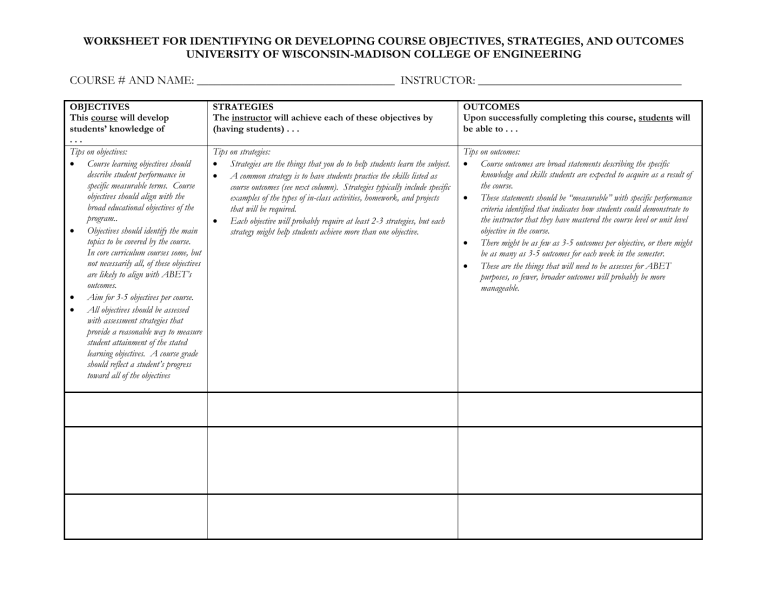engineering ethics – objectives, strategies, & outcomes

WORKSHEET FOR IDENTIFYING OR DEVELOPING COURSE OBJECTIVES, STRATEGIES, AND OUTCOMES
UNIVERSITY OF WISCONSIN-MADISON COLLEGE OF ENGINEERING
COURSE # AND NAME: __________________________________ INSTRUCTOR: ___________________________________
OBJECTIVES
This course will develop students’ knowledge of
. . .
Tips on objectives:
Course learning objectives should describe student performance in specific measurable terms. Course objectives should align with the broad educational objectives of the program..
Objectives should identify the main topics to be covered by the course.
In core curriculum courses some, but not necessarily all, of these objectives are likely to align with ABET’s outcomes.
Aim for 3-5 objectives per course.
All objectives should be assessed with assessment strategies that provide a reasonable way to measure student attainment of the stated learning objectives. A course grade should reflect a student’s progress toward all of the objectives
STRATEGIES
The instructor will achieve each of these objectives by
(having students) . . .
Tips on strategies:
Strategies are the things that you do to help students learn the subject.
A common strategy is to have students practice the skills listed as course outcomes (see next column). Strategies typically include specific examples of the types of in-class activities, homework, and projects that will be required.
Each objective will probably require at least 2-3 strategies, but each strategy might help students achieve more than one objective.
OUTCOMES
Upon successfully completing this course, students will be able to . . .
Tips on outcomes:
Course outcomes are broad statements describing the specific knowledge and skills students are expected to acquire as a result of the course.
These statements should be “measurable” with specific performance criteria identified that indicates how students could demonstrate to the instructor that they have mastered the course level or unit level objective in the course.
There might be as few as 3-5 outcomes per objective, or there might be as many as 3-5 outcomes for each week in the semester.
These are the things that will need to be assesses for ABET purposes, so fewer, broader outcomes will probably be more manageable.
To adjust
To adopt
To advocate
To apply
To arrange
To assemble
To calculate
To catalogue
To categorize
To challenge
To chart
To classify
SAMPLE VERBS FOR DESCRIBING STUDENT OUTCOMES:
To compare To forecast
To cooperate To formulate
To defend
To define
To demonstrate
To describe
To identify
To implement
To install
To investigate
To design
To detect
To estimate
To evaluate
To explain
To express
To isolate
To judge
To list
To locate
To manufacture
To measure
To modify
To operate
To organize
To plan
To prepare
To produce
To question
To recall
To reflect
To state
To transfer
To verify
SAMPLE OBJECTIVES, STRATEGIES, AND OUTCOMES
FOR CEE 698, LECTURE 6: ENGINEERING ETHICS
OBJECTIVES
This course will develop students’ knowledge of
. . .
. . . the nature of engineering ethics (legal, professional, historical, and personal definitions of “engineering ethics”).
. . . the value of engineering ethics
(varied contemporary and historical legal, professional, and personal reasons why an engineer should be ethical).
STRATEGIES
The instructor will achieve each of these objectives by
(having students) . . .
. . . locate and read copies of at least one statute dealing with engineering ethics (liability law, e.g.) and at least one professional engineering society’s code of ethics/conduct.
. . . explore the development of legal and professional definitions of ethics.
. . . analyze research explaining why a personal code of ethics is the most frequently used code.
. . . read at least one example of a personal code and will write their own personal code of ethics.
. . . apply sample codes and laws to a variety of case studies.
. . . review the history and development of engineering licensing laws, liability laws, and codes of ethics.
. . . read about, discuss, and debate the pros and cons of: being [un]ethical, having a code of ethics, and being responsible for “the public safety.”
OUTCOMES
Upon successfully completing this course, students will be able to . . .
locate, describe, and apply the content of at least one example of a law (state, national, or international) dealing with engineering ethics.
locate, describe, and apply the content of the code of ethics/conduct of at least one professional society.
prepare, describe, and defend their own personal definition of what makes for an ethical engineer.
describe and explain historical, legal, professional, and personal reasons why legal and professional definitions of ethics exist.
describe the benefits that are expected to arise from acting ethically.
describe the specific consequences of acting unethically
(according to any of the definitions provided above).
. . . the resolution of ethical dilemmas (using common ethical dilemmas, identify possible actions to be taken in response, and probable consequences of those actions).
. . . practice identifying ethical dilemmas in newspapers, magazines, journals, etc.
. . . read and discuss case studies describing how others have responded to ethical dilemmas and what consequences ensued.
. . . search out, locate, and employ a variety of resources for dealing with ethical dilemmas, including regulations, hotlines, advisors, philosophical rules and models, etc.
. . . brainstorm and discuss possible responses to a wide variety of ethical dilemmas.
. . . apply professional, legal, philosophical, and personal codes to case studies to identify options and limits on their reactions.
identify the ethical dilemmas implicit in a newspaper article or similarly general document.
name at least two possible actions that could be taken in response to a given ethical dilemma.
describe and evaluate the probable consequences of these actions.






